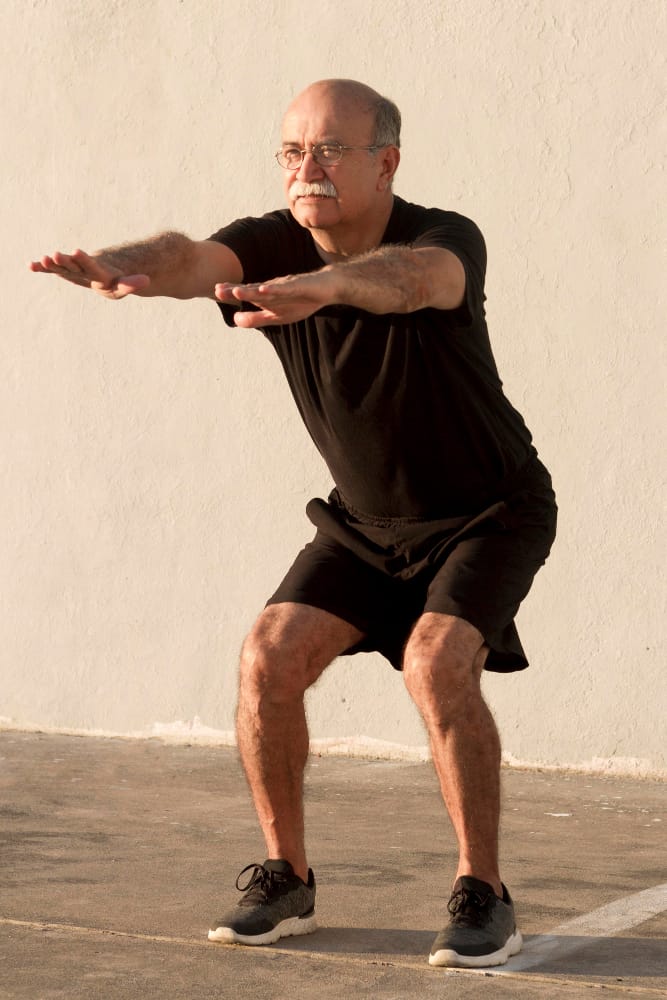FREE SHIPPING OVER $50
The 60-Second ‘Samurai Squat’ That’s Helping Seniors Stay Strong, Mobile, and Independent

As we get older, the biggest threat to our quality of life isn’t necessarily a major illness, but the slow, persistent loss of functional strength and mobility. The everyday actions that we take for granted—getting up from a low chair, climbing stairs without holding the rail, or catching ourselves before a slip—all rely on powerful, balanced leg muscles. Unfortunately, the common senior fitness routines often fall short, focusing too much on low-intensity cardio when what the body truly needs is specific stimulus to fight sarcopenia, or age-related muscle loss.
This is where the innovative, yet simple, 60-Second ‘Samurai Squat’ comes into play. It’s a highly efficient, targeted exercise designed to challenge the three most critical components of senior health: leg strength, balance, and hip mobility. By dedicating just one minute a day to this move, you strategically build the power needed to stay strong, mobile, and independent well into your later years. It’s a game-changer because it prioritizes the exact functional fitness that directly prevents falls and preserves your autonomy.
What is the Samurai Squat and Why is it 60 Seconds?
The Samurai Squat is a variation of a slow, controlled, deep squat, usually performed with the assistance of a chair or low bench for safety. It’s earned its nickname because it focuses on the controlled, balanced strength and deliberate movement reminiscent of martial arts training.
The Power of Time Under Tension
The reason this workout is precisely 60 seconds is based on the principle of Time Under Tension (TUT). Instead of doing fast, high-repetition squats, you perform one or two reps that last a full minute.
- Muscle Stimulus: When you slow down the squat—taking 30 seconds to lower and 30 seconds to stand—you put your muscles under maximum tension for a prolonged period. This low-impact, high-intensity stimulus is incredibly effective at activating fast-twitch muscle fibers (the ones responsible for explosive power and fall prevention) without adding heavy load or joint stress.
- Functional Benefit: The slow descent mimics the real-life movement of controlling your body during a stumble or slowly lowering yourself to the floor, teaching your muscles to fire slowly and deliberately when they need it most.
The Three Pillars: How the Move Boosts Senior Health
The Samurai Squat isn’t just a squat; it’s a compound move that simultaneously works on three distinct health pillars crucial for maintaining independence.
Pillar 1: Rebuilding Leg Strength (Fighting Sarcopenia)
The primary benefit is in directly addressing sarcopenia. The sustained tension of the 60-second move forces the largest muscle groups—the quads and glutes—to contract intensely.
- The Result: This deep muscle activation signals the body to maintain or even rebuild muscle mass. Since the legs are the foundation of all movement, building this strength translates directly to making walking, carrying, and standing up much easier and less taxing on your overall energy.
Pillar 2: Enhancing Balance and Stability
The Samurai Squat requires constant micro-adjustments from your stabilizing muscles to keep the movement slow and controlled, especially during the descent.
- The Result: Your core, hips, and ankle stabilizers are activated to prevent wobble. This greatly improves proprioception (your body’s awareness of its position in space) and reactive strength—the ability to quickly shift weight to avoid a fall.
Pillar 3: Improving Hip Mobility
Many seniors struggle with tight hips due to prolonged sitting, which limits mobility and makes deep squatting impossible. The Samurai Squat safely coaxes the hips into deeper movement.
- The Result: Increasing the range of motion in your hips through controlled movement improves your gait (the way you walk), reduces strain on your knees and back, and allows for greater mobility in daily life, such as bending over to tie your shoes.
The Samurai Squat Protocol: 60 Seconds to Independence
The exercise is simple, but the focus must be entirely on control and time, not speed.
Setup and Preparation
- Safety First: Place a sturdy, stable chair or low bench behind you. This acts as a safe stopping point and reassurance.
- Stance: Stand in a regular squat stance—feet shoulder-width apart, toes pointing slightly out.
- Timing: Use a watch or timer for the 60-second count.
The Movement (The 60-Second Rep)
- The Descent (30 Seconds): Slowly, intentionally, and continuously begin to lower your hips back and down, as if you are sitting in the chair. Take a full 30 seconds to move from standing to fully seated. Your descent should be slow, controlled, and even—stop immediately if you feel pain, but embrace the burning in your muscles.
- The Ascent (30 Seconds): Once your bottom lightly touches the chair, immediately reverse the movement. Push through your feet and take a full 30 seconds to return to the starting, standing position. Do not rush the lockout at the top.
Progression for Beginners
- Phase 1 (Assisted): Use your hands on a stable counter or door frame for assistance during the 60-second rep. The goal is to gradually reduce the pressure you place on your hands as your strength improves.
- Phase 2 (Chair Touch): Perform the move exactly as described, only lightly tapping the chair at the bottom before immediately pushing back up. This removes the resting period.
- Phase 3 (Deeper Range): Once the 60-second rep feels manageable, move to a lower stool or stack of yoga blocks to increase the depth of the squat, thereby increasing the challenge to your muscles and mobility.
Why This Beats Other Senior Workouts
The Samurai Squat is a strategic alternative to many common senior exercises because it targets muscle power, not just muscle endurance.
It’s Not Just Endurance
While walking is essential cardio, it primarily trains slow-twitch muscle fibers for endurance. If you trip, you need fast, powerful muscle contractions to recover your balance—a function controlled by fast-twitch fibers. The slow, intense nature of the Samurai Squat specifically activates these power fibers.
It’s Joint-Friendly
The slow speed is key to reducing joint impact. By moving slowly, you eliminate momentum, forcing the muscles to bear the load, which is exactly what we want for muscle growth. This controlled movement is often safer for individuals with knee or hip sensitivity than faster exercises.
Making the Samurai Squat a Daily Habit
To secure the benefits of increased strength, mobility, and independence, consistency is far more important than intensity.
The Minimum Effective Dose
Perform one 60-second rep every day. That’s all it takes to maintain the muscle signal. However, for faster results, perform 3 sets of 60 seconds with a minute of rest in between, three times a week.
Integrating Functional Strength
Once you’ve mastered the Samurai Squat, integrate other functional movements into your routine to compound the health benefits:
- Carrying: Practice holding a dumbbell or heavy book in one hand while you walk to challenge your core and balance (this mimics carrying groceries).
- Pulling: Use a resistance band for rows to improve posture and upper back strength.
- Stepping: Incorporate step-ups onto a low step to further train single-leg balance and strength—essential for stairs.
Conclusion
The pursuit of independence and longevity in our later years hinges directly on the quality of our muscles and mobility. The 60-Second Samurai Squat offers a powerful, time-efficient solution to combat sarcopenia and bolster balance. By committing just one minute a day to this low-impact, high-intensity move, you effectively train the power and stability needed to confidently navigate daily life. Embrace this focused workout method and actively take control of your fitness so you can continue to stay strong, mobile, and independent no matter your age.
Related Articles
- Knees Caving In When You Squat? Here’s the Real Reason—and the 3 Fixes Pros Never Skip
- Over 40? These 5 Warm-Up Mistakes Are Killing Your Gains—Here’s What to Do Instead
- Sitting Too Much? This One Move Reverses the Damage and Slows Aging, Say Experts
- Over 60? These 3 Exercises Rebuild Strength, Boost Energy, and Keep You Feeling Young
- Why Some Athletes Peak After 40—Neuroscience Reveals the Brain Advantage



